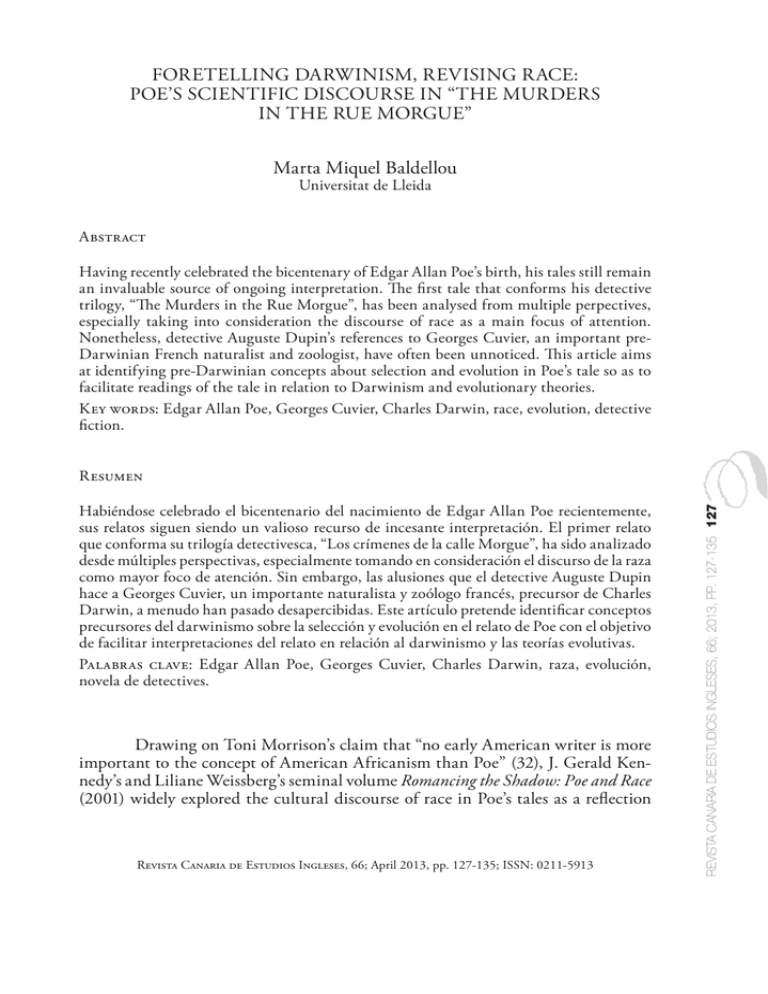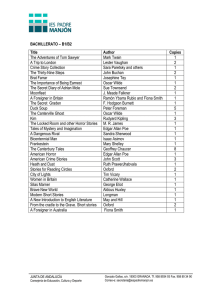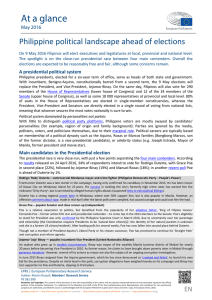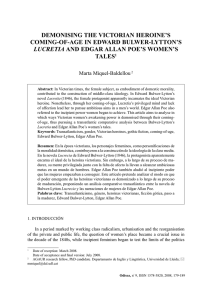FORETELLING DARWINISM, REVISING RACE
Anuncio

FORETELLING DARWINISM, REVISING RACE: POE’S SCIENTIFIC DISCOURSE IN “THE MURDERS IN THE RUE MORGUE” Marta Miquel Baldellou Universitat de Lleida Abstract Having recently celebrated the bicentenary of Edgar Allan Poe’s birth, his tales still remain an invaluable source of ongoing interpretation. The first tale that conforms his detective trilogy, “The Murders in the Rue Morgue”, has been analysed from multiple perpectives, especially taking into consideration the discourse of race as a main focus of attention. Nonetheless, detective Auguste Dupin’s references to Georges Cuvier, an important preDarwinian French naturalist and zoologist, have often been unnoticed. This article aims at identifying pre-Darwinian concepts about selection and evolution in Poe’s tale so as to facilitate readings of the tale in relation to Darwinism and evolutionary theories. Key words: Edgar Allan Poe, Georges Cuvier, Charles Darwin, race, evolution, detective fiction. Habiéndose celebrado el bicentenario del nacimiento de Edgar Allan Poe recientemente, sus relatos siguen siendo un valioso recurso de incesante interpretación. El primer relato que conforma su trilogía detectivesca, “Los crímenes de la calle Morgue”, ha sido analizado desde múltiples perspectivas, especialmente tomando en consideración el discurso de la raza como mayor foco de atención. Sin embargo, las alusiones que el detective Auguste Dupin hace a Georges Cuvier, un importante naturalista y zoólogo francés, precursor de Charles Darwin, a menudo han pasado desapercibidas. Este artículo pretende identificar conceptos precursores del darwinismo sobre la selección y evolución en el relato de Poe con el objetivo de facilitar interpretaciones del relato en relación al darwinismo y las teorías evolutivas. Palabras clave: Edgar Allan Poe, Georges Cuvier, Charles Darwin, raza, evolución, novela de detectives. Drawing on Toni Morrison’s claim that “no early American writer is more important to the concept of American Africanism than Poe” (32), J. Gerald Kennedy’s and Liliane Weissberg’s seminal volume Romancing the Shadow: Poe and Race (2001) widely explored the cultural discourse of race in Poe’s tales as a reflection Revista Canaria de Estudios Ingleses, 66; April 2013, pp. 127-135; ISSN: 0211-5913 REVISTA CANARIA DE ESTUDIOS INGLESES, 66; 2013, PP. 127-135 127 Resumen REVISTA CANARIA DE ESTUDIOS INGLESES, 66; 2013, PP. 127-135 128 of antebellum America. Even if born in Boston, Poe lived in Richmond, Virginia, a southern state, for an extended period of his life, thus imbibing the surrounding perceptions towards race and racism. Critics such as Elise Lemire have referred to the general belief acknowledged in manuals and journals of the time whereby whites considered blacks to be more closely related to primates than themselves. In this respect, the pivotal presence of the ourang-outang in Poe’s tale “The Murders in the Rue Morgue” has frequently and metaphorically been read as the epitome of race disrupting the order that Dupin manages to re-establish again at the end of the story. Nonetheless, even if the tale reflects cultural perceptions of race at the time, it is important not to lose sight of Dupin’s reference to the French naturalist Frederick Cuvier and his descriptive account of the primate of the East Indian Islands. Cuvier’s volume is one of the many pre-Darwinian natural manuals of European origins to which the American readership had access. It is meaningful to notice that this tale has often been interpreted as the disrupture of the black race in America, as Elise Lemire notices, when the actions take place in a European environment and reassess European conceptions of the chain of beings prior to Charles Darwin. After all, the simian in Poe’s story imitates its owner and even escapes from a locked closet to do so; an exhibit that may have urged readers to notice any similarities between monkeys and humans. Even if many interpretations of the story have been based on Freudian premises and the return of the repressed, taking Marie Bonaparte as a case in point, the figure of the ourang-outang may also be envisioned at a more literal level. Simians seemed to confirm the animal kingdom was hierarchical and continuous, so that monkeys began to be viewed as the missing link between humans and animals. In this respect, this article aims at reassessing critical studies of race and detect pre-Darwinian ideas about selection and evolution in Poe’s tale after recently celebrating the bicentenary of both Edgar Allan Poe and Charles Darwin in 2009. In 1839, two years before publishing his first detective story, “The Murders in the Rue Morgue,” Poe issued an illustrated textbook on conchology under the title The Conchologist’s First Book; or, A System of Testaceous Malacology. Even though the book was printed under Poe’s name, the actual author was Thomas Wyatt, an English lecturer, who had written the original textbook entitled Manual of Conchology. Poe only wrote the preface and the introduction, and yet, it was agreed he would lend his name as the author of the book. Wyatt’s volume had already been published by Harper and Brothers in an extended and richly illustrated edition that was remarkably expensive for young students of conchology, so that Wyatt decided to issue a cheaper edition. However, Harper and Brothers were reluctant to publish a second edition that would compete with sales of their first publication. As a matter of fact, they decided to include Poe as the author of this second edition to avoid copyright problems with the original book, and ease its circulation in the literary market, believing Poe’s name would aid in popularising the book. Likewise, as Silverman asserts, Wyatt agreed to allow Poe’s authorship because “he [Poe] needed money very sorely at the time” (138). Even though Poe was not the actual author of the book, he introduced important changes in Wyatt’s volume. In addition to editing and organising the It was a minute anatomical and generally descriptive account of the large fulvous Ourang-Outang of the East Indian Islands. The gigantic stature, the prodigious strength and activity, the wild ferocity, and the imitative propensities of these mammalian are sufficiently well-known to all. I understood the full horrors of the murder at once. (Poe, Portable 367) Thus, not only did Poe include an explicit reference to Georges Cuvier in his first detective tale, but it is also implied Dupin manages to solve the puzzle due to Cuvier’s enlightening account of a simian. Poe studied and analysed Cuvier’s theories to edit a second edition of Wyatt’s original volume, and taking into consideration Poe’s allusion to Cuvier’s work in his tale, he may have also become an admirer of his theories. Georges Cuvier, of humble origins, was a highly-respected self-made scholar, and due to his scientific contributions as a naturalist and zoologist, he became a major figure in natural science in the early 19th century. Even though Charles Darwin’s theories have demeaned his contribution, Cuvier is still nowadays especially acknowledged for establishing the field of palaeontology by comparing living animals with fossils, thus proving that species become extinct in the course of time. Until Cuvier’s theory in 1796, it was believed no species of animals became extinct because God’s perfect creation could not allow any creature to disappear. Moreover, two years later, Cuvier would establish the principle of correlation of parts, which bears REVISTA CANARIA DE ESTUDIOS INGLESES, 66; 2013, PP. 127-135 129 volume, he also created a new classification which differed from Wyatt’s taxonomy, and contributed significantly to simplifying and condensing the original work. Nonetheless, for the purpose of this article, Poe’s most important contribution in relation to Wyatt’s manual was his translation of Georges Cuvier’s passages from French into English. Wyatt’s original volume included some excerpts written by the French naturalist and zoologist Georges Cuvier. Poe was fluent in French, and used his linguistic skills to analyse and translate Cuvier’s scientific classification schemes with special regard to his accounts of animals. In this respect, as Stephen Jay Gould has noticed, Poe contributed significantly to simplifying and popularising scientific methodologies of analysis and arrangement in 19th-century America, thus introducing Wyatt’s and Cuvier’s manuals on natural history in the United States. As Alan Marcus contends, drawing on European precedents, the early history of science in America was dominated by two main issues: the first focused on individuals who were identified as great men and asked how they had reasoned when they achieved their greatness; the second concentrated on current knowledge and determined the relevant steps to be taken in the march that led to a particular enlightenment (334). Poe’s task as an editor and translator of Wyatt’s book may have also exerted an important influence on his ideas about detection, and above all, the analytical skills for which his detective Dupin would be remembered ever after. Actually, Dupin unravels the puzzle of the murders in the Rue Morgue through explicit references to the French naturalist. When the perplexed narrator feels incapable of solving the deaths of Madame L’Espanaye and her daughter Camille, Dupin advises him to read a passage from Cuvier which he describes as follows: a remarkably close resemblance with Dupin’s method of analysis. In this respect, Cuvier described this principle in the following terms: REVISTA CANARIA DE ESTUDIOS INGLESES, 66; 2013, PP. 127-135 130 Today comparative anatomy has reached such a point of perfection that, after inspecting a single bone, one can determine the class, and sometimes even the genus of the animal to which it belonged, above all if that bone belonged to the head or the limbs. [...] This is because the number, direction, and shape of the bones that compose each part of an animal’s body are always in a necessary relation to all the other parts, in such a way that—up to a point—one can infer the whole from any of them and vice versa. Cuvier thus contended that all parts of a being are necessarily connected to one another, and through the gathering of individual parts, it becomes possible to infer the wholeness of any being. Consequently, he concluded that no part of any being could be modified in isolation from the rest of its parts. Cuvier was critical of the gradualistic theories of evolution proposed by his contemporary Lamarck, which would ultimately end in Darwin’s theory of evolution by natural selection and which involved the gradual transformation of one form into another. Instead, Cuvier argued that one fossil does not gradually change into a succeeding distinct fossil, but rather, a typical form appears abruptly and remains unchanged until its extinction. Cuvier was thus a creationist rather than an evolutionist, arguing that new types abruptly replace older ones in the fossil records, thus rejecting evolution takes place through slow changes in progress. However, Cuvier’s theories about extinction, the correlation of all parts to create a whole being, and his ideas of replacement of old species by new ones remained important contributions to the field prior to Darwin’s theory of evolution. In the early 19th century, when Cuvier was a reputed naturalist, Darwin was merely a young student, and so was Poe, born in the same year. Even though Darwin did not publish his Origin of Species until 1859, he set on the journey to the Galapagos Island, which would prove decisive for his theories, in 1835, and published his initial findings in his volume The Voyage of the Beagle in 1839, that is, the very same year Poe published The Conchologist’s First Book in America, with numerous references to Georges Cuvier. Through Cuvier, Poe became acquainted with scientific reasoning and taxonomy, thus adopting a method of analysis that he would apply not only to his detective stories, but also to his particular way of conceptualising his craft and artistry. As he would later show in “The Philosophy of Composition”, he was well aware of his creative method and the way to proceed in his writing to achieve the ultimate effect: “[n]othing is more clear than that every plot, worth the name, must be elaborated to its dénouement before anything be attempted with the pen” (Portable 549-550). Thus, it is only with a view to its final result that all actions in the tale should be considered beforehand, echoing Cuvier’s thesis arguing that all parts of a being must be connected to one another. Drawing on Poe’s scientific reasoning, the final effect of “The Murders in the Rue Morgue” is brought to light through Cuvier’s passage on the wild and imitative nature of the East Indian simian and thus his work on comparative anatomy, Leçons d’anatomie comparée, published in 1800. Consequently, aware of this final effect from the beginning of the tale, it is possible to identify Dupin’s, and thus, Poe’s, methods of reasoning, which resemble some of Cuvier’s theories. In “The Murders in the Rue Morgue,” the narrator widely discusses and praises the analytical method of the player in a game of draughts. Echoing Cuvier’s principle of correlation of parts, which preaches each part of a body is in necessary relation to the rest, the narrator contends that each detail matters to the player, so that he is supposed to remain attentive and observant all through the game. Deprived of other resources, the analyst must identify himself with his opponent so as to anticipate his moves. Consequently, all chain of events taking place during the game is important for the analyst who observes and makes inferences until he manages to solve the puzzle. In this respect, as the narrator in the tale contends: Likewise, in a game of draughts all moves are unique and have little variation, so that any advantage obtained must be due to a “strong exertion of the intellect” (Poe, Portable 334), which ultimately ends with the analyst’s success, and his opponents’ complete bafflement. In this respect, during the game, the analyst’s powers of mind decode any change effected by the rest of players, indulging in a combination of observation and inference, until he is able to identify their procedure, and thus foretell their moves in advance. In clear analogy with Cuvier’s creationist principles, those which claimed new species of fossils came into being abruptly, all players’ moves take place suddenly and can only be retrieved by the analyst’s superior intellect, which ultimately echoes Darwin’s natural selection of the survival of the fittest. In this respect, the narrator’s description of the analyst’s procedure to observe, detect, anticipate his opponents’ moves and take action seems to foretell Darwin’s description in The Origin of Species: It may metaphorically be said that natural selection is daily and hourly scrutinising, throughout the world, every variation, even the slightest; rejecting that which is bad, preserving and adding up all that is good; silently and insensibly working, whenever and wherever opportunity offers, at the improvement of each organic being in relation to its organic and inorganic conditions of life. (70) Similarly, the player observes each opponent, and carefully selects his moves accordingly, just as the detective observes each clue until the puzzle is deciphered. In this respect, the narrator’s long introduction to the analyst’s capacities of observation and inference when playing draughts also foretells Dupin’s powers of reasoning later on in the tale. Thus, just as the player decodes his opponents’ moves to win the game, Dupin’s analytical method unravels the course of the narrator’s thoughts. Through his observance and the associative workings of memory, Dupin manages to guess the narrator’s mental moves by providing different links. Actu- REVISTA CANARIA DE ESTUDIOS INGLESES, 66; 2013, PP. 127-135 131 The first two or three rounds having been played, he [the analyst] is in full possession of the contents of each hand, and thence-forward puts down his cards with as absolute a precision of purpose as if the rest of the party had turned outward the faces of their own. (Poe, Portable 335-336) REVISTA CANARIA DE ESTUDIOS INGLESES, 66; 2013, PP. 127-135 132 ally, Dupin mentions “the larger links of the chain run thus—Chantilly, Orion, Dr. Nichols, Epicurus, Stereotomy, the street stones, the fruiterer” (Poe, Portable 340). Dupin’s explicit allusion to the links of the narrator’s mental chain seems to foretell the evolution of the chain of beings, just as the narrator’s thoughts evolve through association, through linking one event to another until its final resolution. In this respect, Poe establishes a parallelism between the analyst’s course of thoughts, the player’s observance in a game of draughts, and ultimately, the writer’s procedure to create a text. Resembling a player of draughts, Dupin manages to retrace and re-enact the narrator’s chain of events to guess his present thoughts. Furthermore, the narrator will echo Poe’s procedures to write the tale, so that this process is repeated and reverberates ever after. The player, Dupin, the narrator, and by extension, Poe himself, observe, select, infer and act accordingly. They are all aware of the evolution of thought until its final resolution so that they never act until they have mentally gone through the whole procedure, thus employing an inductive method of analysis. Dupin’s analytical method is based on the observance of meaningful details, which he associates to create a chain of links that brings forward the solution of the puzzle. Nonetheless, in addition to these details, Dupin’s creativity and imagination is also demanded. In this respect, the narrator mentions Dupin was a double character, as he was as resolute as creative. Dupin’s bi-part soul, as the narrator mentions, also echoes Cuvier’s theories as he argued all parts of a being are correlated, but chance is also necessary to ensure modification, and ultimately, evolution, as Darwin would prove. Darwin would contend natural selection, which takes place gradually and unavoidably, was responsible for the improvement and the evolution of species. In this sense, Dupin carefully selects details such as the criminal’s undistinguishable voice, or the nail from the window, establishing an analogy between the course of his thoughts and that of natural selection. He actually mentions his deductions may “engender a suspicion which should give direction to all farther progress in the investigation” (Poe, Portable 357), and similarly, he also states “there was no flaw in any link of the chain” (Poe, Portable 360). This particular use of the language and his constant allusion to Dupin’s analytical methods betray Poe’s readings as regards the scientific method, as well as Cuvier’s correlation of parts and views on evolution. When Poe edited The Conchologist’s First Book, he translated Cuvier’s accounts of animals, among which there was an explicit reference to the East Indian simian that would later appear in Poe’s tale. In his research, Cuvier mainly focused on a comparative analysis between the skeletons of living animals and fossils of extinct animals, to identify their similarities and provide a classification of the animal kingdom. Nonetheless, Cuvier rejected any gradual transformation of one form into another, as Lamarck and Darwin would later propose. Instead, Cuvier believed a particular type or species made an abrupt appearance in an environment, mainly through immigration, not creation. These theories bear a close resemblance with the simian’s violent and sudden appearance in Madame L’Espanaye’s chamber. Brought to France by a sailor, the simian has been removed from his natural environment, and escapes his master’s dwellings. His innocent but wild nature is remindful of REVISTA CANARIA DE ESTUDIOS INGLESES, 66; 2013, PP. 127-135 133 the noble savage, especially taking into consideration Poe’s personifying traits so as to describe the primate. Poe was well aware of the ‘imitative propensities’ of simians, as Cuvier claimed in his book, and accordingly, as the tale unfolds, the simian imitates his master’s habit of shaving by “flourishing the razor” (Poe, Portable 374) over Madame L’Espanaye’s face, and ultimately, killing her unwillingly. The simian in Poe’s tale has been the object of manifold interpretations, which have often ignored a more literal reading of his character. In her early psychoanalytical accounts, Marie Bonaparte interpreted the simian’s murder of Madame L’Espanaye as the contemplation of the primal scene, thus associating the simian with the furious workings of nature and life-force. Thus, the simian impersonates the return of the repressed to disturb and destroy the order established. Much attention has also been paid to the simian’s human-like features. His ability to imitate his master, as well as his need to conceal his murder as a result of fear and guilt, endow him with some personality of his own. In this respect, Cuvier’s and Poe’s depiction of the East Indian simian is not entirely different from the historical account of many of the African-American slaves living in Richmond, where Poe resided for many years. As Elise Lemire contends, manuals and journals of the time considered black people to be closely related to primates, and accordingly, the parallelism between primates and slaves led Elise Lemire to interpret the simian’s murder as a scene of interracial sex. Poe was arguably aware of the notions of racial hierarchy in his lifetime as he lived in a slave society. Likewise, as Lindon Barrett noticed, Dana Nelson, in The World in Black and White (1993), already referred to the everlasting controversy whether Poe held pro- or anti-slavery sentiments. And yet, even though the parallelism established between primates and slaves during Poe’s time has been widely acknowledged so as to interpret his tale, Cuvier’s influence on Poe has often been disregarded. After all, Poe had translated Cuvier’s theories to include them in his Conchologist’s First Book only two years before he published “The Murders in the Rue Morgue,” and Dupin explicitly refers to Cuvier’s accounts of the East Indian primate. Moreover, Cuvier’s principle of the correlate parts reverberates along Poe’s tale, especially through the narrator’s depiction of the analyst’s method, and Dupin’s powers of reasoning and deduction. In this respect, Dupin’s continuous reference to the links in a chain, while gathering all the clues, so as to reach the end of his process, bears a close resemblance with evolution, thus establishing a parallelism between Dupin’s inductive method and Cuvier’s scientific scheme. Dupin scrutinises and categorises all the witnesses, providing an accurate description of all of them, not unlike Cuvier’s classification of species. Moreover, Cuvier’s theory about the abrupt appearance of a new species due to immigration echoes the simian’s disruptive presence in Madame L’Espanaye’s chamber, once he is removed from his natural environment. Even though Cuvier did not share Lamarck’s views on evolutionary theories that would ultimately lead to Darwin’s theory, his status as a naturalist and zoologist was never argued at the time. However, Poe’s tale surprisingly even goes beyond to foretell Lamarck’s, and later, Darwin’s theory of evolution. In this respect, the sailor’s simian is only brought on stage after Dupin’s explicit reference through Cuvier’s manual. Thus, the ourang-outang appears as the missing link of Dupin’s REVISTA CANARIA DE ESTUDIOS INGLESES, 66; 2013, PP. 127-135 134 chain to solve the puzzle. The order established in the French quarter where Madame L’Espanaye and her daughter live is disrupted by a simian whose attributes are remarkably human-like. These women’s inability or unwillingness to reproduce, and thus evolve and improve, is counteracted by the simian as a personification of the life-force. In this respect, as an unexpected predecessor of their own species, the simian punishes these women’s for their stagnant state, while Dupin, like a scientist, echoing Cuvier’s own procedure, observes the scene, takes notes, and presents his theory to solve the puzzle. Moreover, taking into consideration Dupin’s resoluteness and creativity, his inductive method appears not far removed from Poe’s own systematic craft as a writer. Poe’s personal interpretation of the evolutionary theories can also be perceived in his creative process as depicted in “The Philosophy of Composition.” Actually, as Van Doren already pointed out, “Poe is trying here to apply the same faculties he used in deciphering a cryptogram or in working out a solution of the Mary Rogers murder case to explain the processes of artistic creation” (548). To conclude, it is thus possible to establish a parallelism between Cuvier’s scientific discourse in natural history, and Dupin’s inductive method which, all together, echo Poe’s concern about analysis and effect. Poe felt the need to retrace the steps he had followed when creating a story so that each action would contribute to echoing its final resolution. Poe had his own theory of evolution which surprisingly echoed Cuvier’s theories and foretold Darwin’s theory in The Origin of Species, which would finally come to light almost two decades after Poe’s publication of “The Murders in the Rue Morgue.” In this respect, Poe’s translation of the French naturalist’s theories to edit The Conchologist’s First Book was crucial to develop his scientific method and his concern about analysis. Likewise, as Poe’s own double, Dupin, exemplified the cautious and rigorous methodologies of the scientist. Hence, “The Murders in the Rue Morgue” should not only be regarded as Poe’s first detective tale but also as a meaningful display of Poe’s scientific method which would later portray in “The Philosophy of Composition,” thus determining his creative artistry ever after. After all, as a contemporary biographer, Peter Ackroyd, claims, Poe often confessed the power of his studies precisely lay in their “air of method.” WORKS CITED Ackroyd, Peter. Poe: A Life Cut Short. London: Chatto and Windus, 2008. Barrett, Lindon. “Presence of Mind: Detection and Racialization in ‘The Murders in the Rue Morgue’.” Romancing the Shadow: Poe and Race. Ed. J. Gerald Kennedy and Liliane Weissberg. Oxford: Oxford UP, 2001. 157-176. Bonaparte, Marie. The Life and Works of Edgar Allan Poe: A Psychoanalytic Interpretation. Trans. John Rodker. London: The Hogarth, 1971. Cuvier, Georges. “Paper on the Fossil Remains of an Animal Found in Some Plaster Quarries Near Paris.” Unpublished. 1798. Darwin, Charles. The Origin of Species. 1859. Oxford: Oxford UP, 1998. Gould, Stephen Jay. “Poe’s Greatest Hit.” Natural History 102.7 (July 1993): 10-19. Lemire, Elise. “‘The Murders in the Rue Morgue’: Amalgamation Discourses and the Race Riots of 1838 in Poe’s Philadelphia.” Romancing the Shadow: Poe and Race. Ed. J. Gerald Kennedy and Liliane Weissberg. Oxford: Oxford UP, 2001. 177-204. Marcus, Alan I. “Science and Technology.” A Companion to 19th-century America. Oxford: Blackwell, 2006. 334-344. Morrison, Toni. Playing in the Dark: Whiteness and the Literary Imagination. Cambridge: Harvard UP, 1992. Nelson, Dana. The Word in Black and White: Reading “Race” in American Literature, 1638-1867. New York: Oxford UP, 1993. Poe, Edgar Allan, ed. The First Conchologist’s Book; or, A System of Testaceous Malacology. Based on Thomas Wyatt’s Manual of Conchology. 1839. —— The Portable Poe. Ed. Philip Van Doren Stern. 1841. New York: Penguin, 1986. Silverman, Kenneth. Edgar A. Poe: Mournful and Never-Ending Remembrance. New York: Harper Perennial, 1991. REVISTA CANARIA DE ESTUDIOS INGLESES, 66; 2013, PP. 127-135 135 Van Doren Stern, Philip. “Criticism: Editor’s Preface.” The Portable Poe. New York: Penguin, 1986. 547-549.









